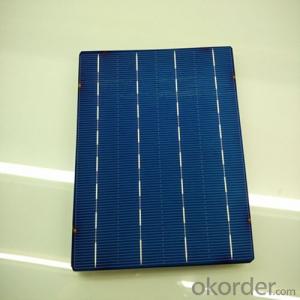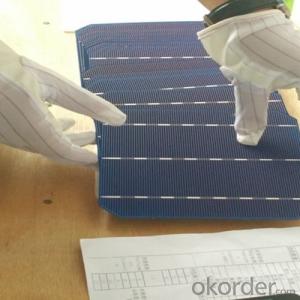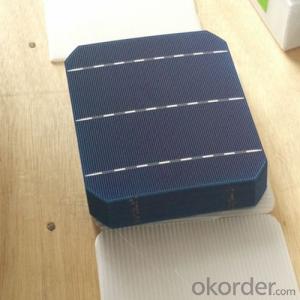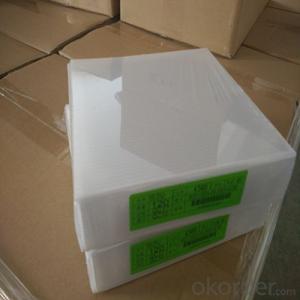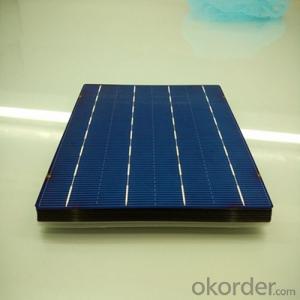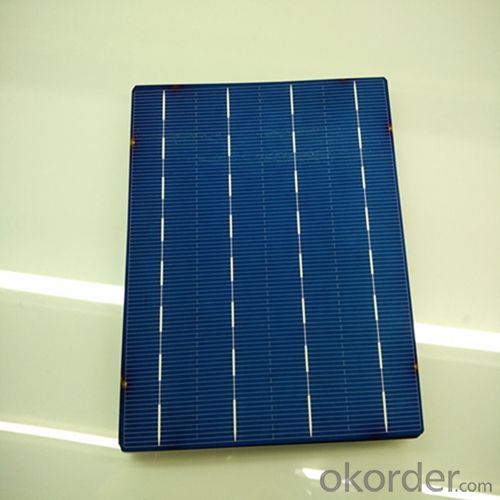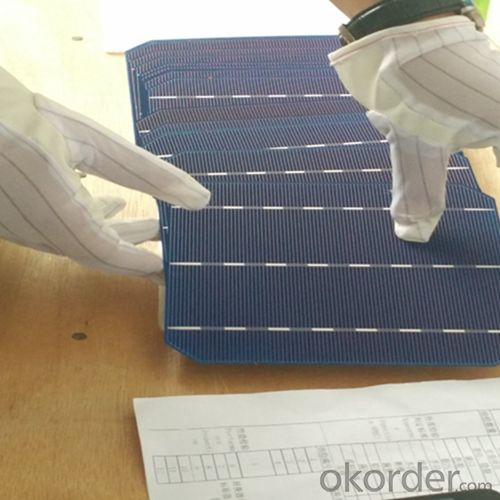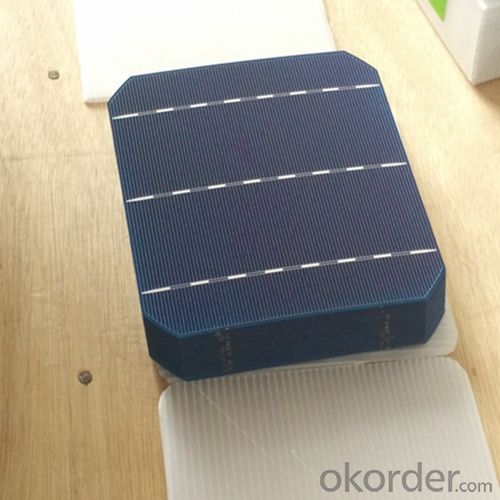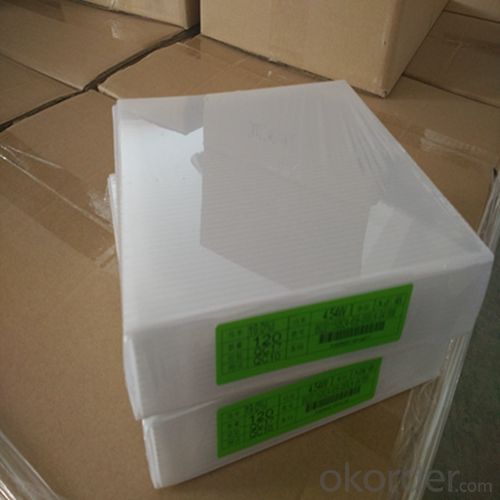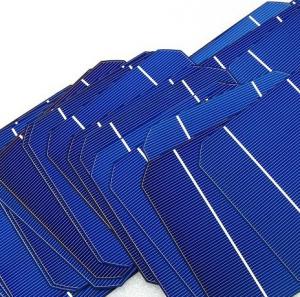Multijunction Solar Cells - Poly 156x156mm2 Class A Solar Cells
- Loading Port:
- Shanghai
- Payment Terms:
- TT OR LC
- Min Order Qty:
- 6500 watt
- Supply Capability:
- 6000000 watt/month
OKorder Service Pledge
OKorder Financial Service
You Might Also Like
The operation of a photovoltaic (PV) cell requires 3 basic attributes:
The absorption of light, generating either electron-hole pairs or excitons.
The separation of charge carriers of opposite types.
The separate extraction of those carriers to an external circuit.
In contrast, a solar thermal collector supplies heat by absorbing sunlight, for the purpose of either direct heating or indirect electrical power generation from heat. A "photoelectrolytic cell" (photoelectrochemical cell), on the other hand, refers either to a type of photovoltaic cell (like that developed by Edmond Becquerel and modern dye-sensitized solar cells), or to a device that splits water directly into hydrogen and oxygen using only solar illumination.Characteristic of Mono 156X156MM2 Solar Cells
You are gaining energy independence - add battery backup power for even greater energy security
The cost of electricity is only going to rise – insure against that rising cost
Adaptive cells change their absorption/reflection characteristics depending to respond to environmental conditions. An adaptive material responds to the intensity and angle of incident light. At the part of the cell where the light is most intense, the cell surface changes from reflective to adaptive, allowing the light to penetrate the cell. The other parts of the cell remain reflective increasing the retention of the absorbed light within the cell.[67]
In 2014 a system that combined an adaptive surface with a glass substrate that redirect the absorbed to a light absorber on the edges of the sheet. The system also included an array of fixed lenses/mirrors to concentrate light onto the adaptive surface. As the day continues, the concentrated light moves along the surface of the cell. That surface switches from reflective to adaptive when the light is most concentrated and back to reflective after the light moves along
Mechanical data and design
Format | 156mm x 156mm±0.5mm |
Thickness | 210μm±40μm |
Front(-) | 1.5mm bus bar (silver),blue anti-reflection coating (silicon nitride) |
Back (+) | 2.5mm wide soldering pads (sliver) back surface field (aluminium) |
Temperature Coefficient of Cells
Voc. Temp.coef.%/K | -0.35% |
Isc. Temp.coef .%/K | +0.024%/K |
Pm.Temp.coef. %/K | -0.47%/K |
Electrical Characteristic
Effiency(%) | Pmpp(W) | Umpp(V) | Impp(A) | Uoc(V) | Isc(A) | FF(%) |
18.35 | 4.384 | 0.526 | 8.333 | 0.63 | 8.877 | 78.39% |
18.20 | 4.349 | 0.526 | 8.263 | 0.63 | 8.789 | 78.54% |
18.05 | 4.313 | 0.525 | 8.216 | 0.63 | 8.741 | 78.32% |
17.90 | 4.277 | 0.524 | 8.161 | 0.625 | 8.713 | 78.04% |
17.75 | 4.241 | 0.523 | 8.116 | 0.625 | 8.678 | 77.70% |
17.60 | 4.206 | 0.521 | 8.073 | 0.625 | 8.657 | 77.36% |
17.45 | 4.170 | 0.519 | 8.039 | 0.625 | 8.633 | 76.92% |
17.30 | 4.134 | 0.517 | 8.004 | 0.625 | 8.622 | 76.59% |
17.15 | 4.096 | 0.516 | 7.938 | 0.625 | 8.537 | 76.80% |
17.00 | 4.062 | 0.512 | 7.933 | 0.625 | 8.531 | 76.18% |
16.75 | 4.002 | 0.511 | 7.828 | 0.625 | 8.499 | 75.34% |
16.50 | 3.940 | 0.510 | 7.731 | 0.625 | 8.484 | 74.36% |
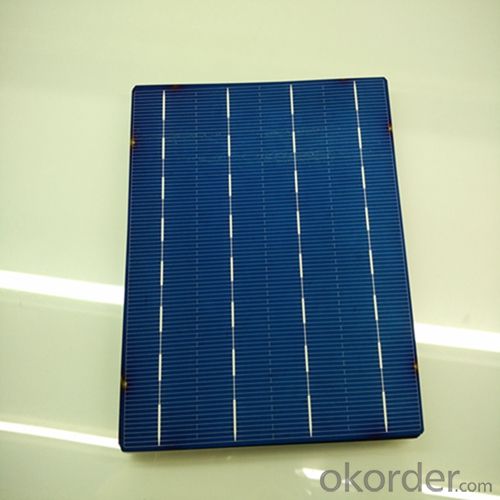
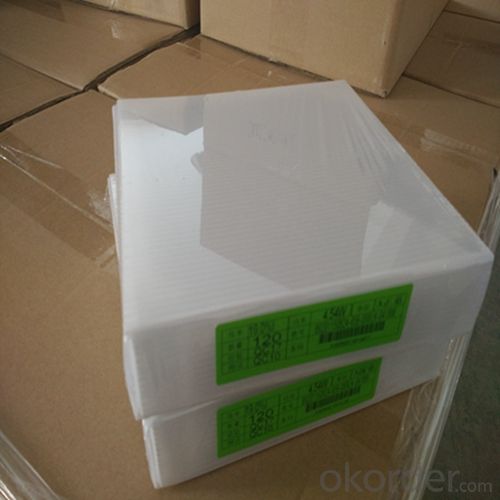
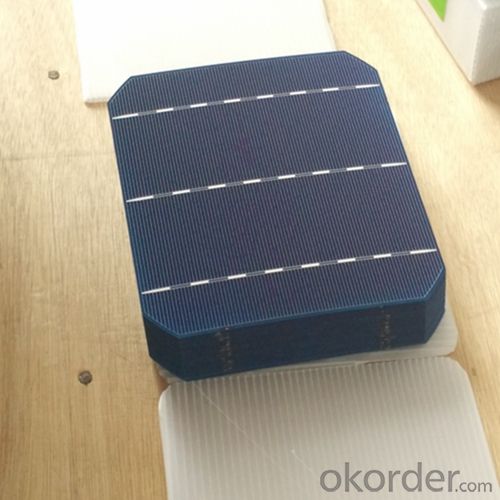
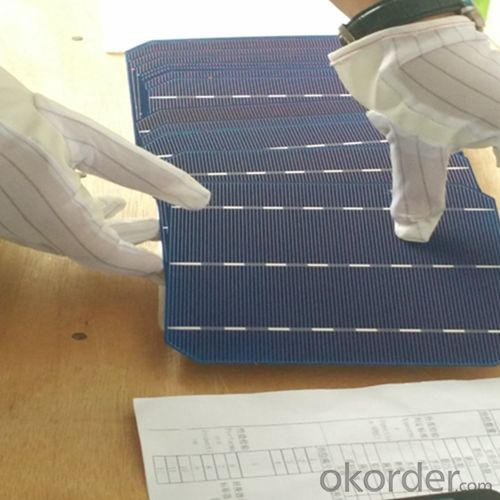
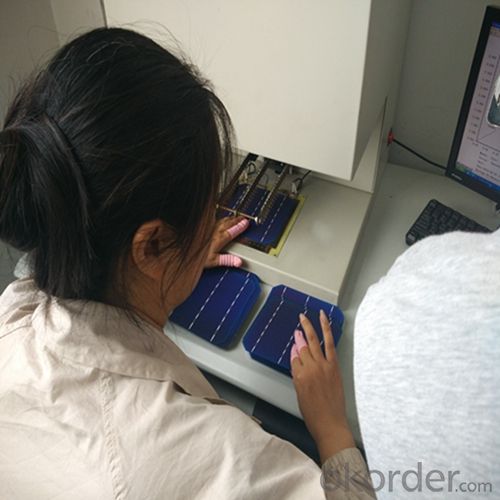 FAQ
FAQ
Q: What price for each watt?
A: It depends on the quantity, delivery date and payment terms, generally Large Quantity and Low Price
Q: What is your size for each module? Can you tell me the Parameter of your module?
A: We have different series of panels in different output, both c-Si and a-Si. Please take the specification sheet for your reference.
Q: What is your size for each module? Can you tell me the Parameter of your module?
A: We have different series of panels in different output, both c-Si and a-Si. Please take the specification sheet for your reference.
- Q: Can solar cells be used in disaster relief or emergency response situations?
- Yes, solar cells can be used in disaster relief or emergency response situations. Solar cells provide a reliable and renewable source of energy that can be used to power critical devices and infrastructure such as communication systems, medical equipment, lighting, and water purification systems. They are easily deployable, independent of the electrical grid, and can operate in remote areas, making them ideal for emergency situations where access to traditional power sources may be disrupted.
- Q: What is the cost of solar cells?
- The cost of solar cells can vary depending on factors such as the type of technology, efficiency, and quality. Generally, the cost ranges from $0.30 to $0.80 per watt.
- Q: How do solar cells perform in regions with high levels of humidity and rainfall?
- Solar cells can still perform well in regions with high levels of humidity and rainfall. While excessive moisture can temporarily reduce their efficiency, modern solar cell designs are built to withstand such conditions. Additionally, rainwater can actually help to clean the surface of the solar panels, improving their performance in the long run.
- Q: Can solar cells be used in greenhouses?
- Yes, solar cells can be used in greenhouses. They can help generate clean and renewable energy to power various functions in the greenhouse, such as lighting, ventilation, and irrigation systems. By harnessing the sun's energy, solar cells contribute to making greenhouses more sustainable and reducing reliance on fossil fuels.
- Q: What is the role of solar cells in solar-powered water heaters?
- The role of solar cells in solar-powered water heaters is to capture sunlight and convert it into electricity. This electricity is then used to power the heating element or pump in the water heater, allowing it to heat water using clean and renewable energy from the sun.
- Q: Why and what is the low efficiency solar cell?
- Sometimes the solar cells made of bad quality silicon can cause the result that the solar cells you are using is lower efficient than when you started to use it. You might need to change some materials.
- Q: What is the efficiency of a typical solar cell?
- The efficiency of a typical solar cell is around 15-20%.
- Q: Can solar cells be used in indoor applications?
- Yes, solar cells can be used in indoor applications. While they are typically designed for outdoor use to harness sunlight, indoor solar cells can still generate electricity from artificial light sources such as fluorescent or LED lights. However, the efficiency of indoor solar cells is generally lower compared to outdoor usage due to the lower intensity and variability of indoor lighting.
- Q: Can solar cells generate electricity on cloudy days?
- Yes, solar cells can generate electricity on cloudy days, although the amount of electricity produced may be significantly reduced compared to sunny days.
- Q: Can solar cells be used for powering traffic lights?
- Yes, solar cells can be used for powering traffic lights. Solar cells convert sunlight into electricity, which can be stored in batteries and used to power various devices, including traffic lights. This helps reduce dependence on the electrical grid and promotes renewable energy use.
Send your message to us
Multijunction Solar Cells - Poly 156x156mm2 Class A Solar Cells
- Loading Port:
- Shanghai
- Payment Terms:
- TT OR LC
- Min Order Qty:
- 6500 watt
- Supply Capability:
- 6000000 watt/month
OKorder Service Pledge
OKorder Financial Service
Similar products
Hot products
Hot Searches
Related keywords
